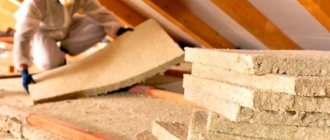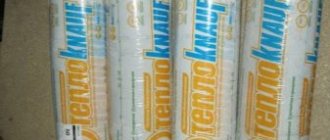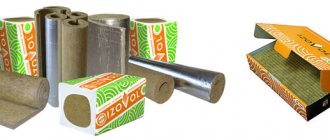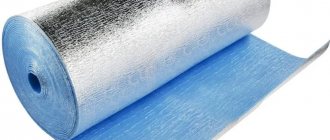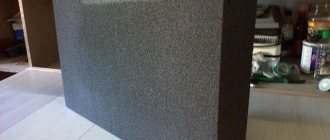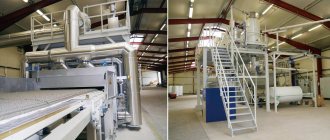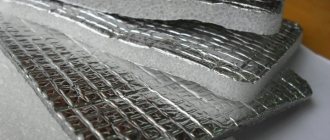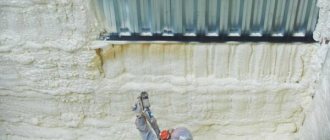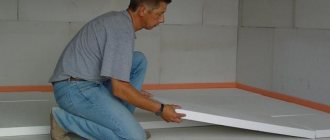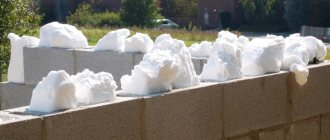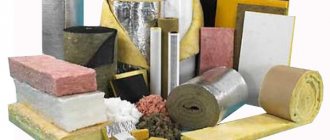Not a single new building will last even ten years if it was built without the use of thermal insulation materials. Thanks to them, maximum heat savings are achieved, the absence of drafts and “cold bridges” inside the walls, and the service life declared by the manufacturers allows you to forget about major repairs of the building for decades.
Among insulation materials, mineral wool is considered one of the market leaders in a number of parameters. It is divided into three groups:
- basalt;
- glass wool;
- slag.
The process of making one mineral wool is different from another, but the meaning of use remains the same - achieving maximum comfort with minimal expenditure of money and effort. In this case, it is desirable to fulfill a number of operational and GOST-prescribed requirements.
Among mineral wool, the materials of the “IZO-” series stand apart. They appeared on the market relatively recently, but are already in consumer demand. Made from natural raw materials with a minimum amount of artificial additives, insulation materials are supplied in slabs or rolls, and one of them, called Izobel, will be discussed in more detail.
Features of insulation
The area of use of isobel is reducing the thermal conductivity of buildings for various purposes. In the production of insulation, EcoSafe technology is used, which reduces the amount of moisture absorbed by the material. Izobel slabs are a type of basalt wool (material with the lowest thermal conductivity coefficient) and are manufactured without the use of blast furnace slag. Usually the insulation has a standard size (1000×600 mm, 1000×1000 mm, etc.).
Isobel can be produced not only from heavy basalt rocks, but also from lighter ones such as limestone or quartzite.
The resulting slabs weigh less and do not hold heat as well, but their density is higher, which affects durability. Similar izobel is used for cladding areas of the house where thermal insulation does not play a special role, but fire resistance and noise absorption are much more important (non-residential attics, ceilings, pitched roofs).
Where is Isovol used?
IZOVOL
This material is widely used in individual construction and industrial purposes. From private use, the following areas of insulation can be noted:
- Facade with plaster coating
- Ventilated facade
- Three-layer masonry, where the middle layer is insulation
- Frame walls
- Foundation and floor
- Interfloor ceilings
- Pitched roof
- Technical insulation
In industrial construction, Izovol is used to create sandwich panels and insulate flat roofs in single- and double-layer coatings. Izovol KV-150 is produced in slabs up to 18 cm thick.
Different forms of release of Izovol *
Features of isobel installation
Due to its ease of use, insulation is used almost everywhere. Thermal insulation with its help will be justified in the following places:
- partitions between floors;
- floor;
- roofs with a slope;
- attics;
- walls.
The only place that is undesirable to insulate with isobel is the foundation, since the slabs can get wet from interaction with the soil and fail.
Like any other mineral wool, insulation requires two additional layers - hydro- and vapor barrier. The first protects the slabs from getting wet from the outside, the second - from the inside. When installing isobel on a sloping roof, it is recommended to create an air gap, the purpose of which is to remove accumulated condensate.
The key difference between isobel as mineral wool and polystyrene foam is that it is not mounted directly to the wall with glue, but is placed inside cells formed by a wooden sheathing. The advantage of this need is additional strengthening of the building frame, the disadvantage is financial investment.
Reviews
Alexey, 36 years old, Samara
Izobell slabs retain heat. The main thing is to arrange them well. The sheets vary, the outside of the package is soft, especially the edges - they wrinkle during transportation.
Igor, 42 years old, Izhevsk
I bought it for a frame bath. When insulating Izovol, I did not make lintels in the walls, since the ceiling height is 2.3 m. Isobel is no worse than expensive material. I want to insulate the attic floor with a layer of 30 cm. The savings when purchasing 30 m³ will be significant.
Stepan, 55 years old, Belgorod
The frame was insulated. They create a lot of dust when installing. Nothing has settled in a year. I came across a pack of Isobel, bought 3 years ago. The quality of the slabs varies greatly in favor of those purchased later.
Sergey, 39 years old, Pushchino
I bought a pack of Isobel L-25. I was surprised by the low price, clear shape and elasticity of the sheets - like foam rubber. They cut well with a utility knife, but it needs to be sharpened often. They fit well and elastically into the frame. I can’t understand why it’s called economy class and what the manufacturers saved on.
Material Specifications
Izobel insulation materials have approximately equal physical properties. For example, a slab measuring 1000×600 mm is considered below. Its characteristics will be:
- density - 25 kg/cubic. m;
- thickness - from 40 to 250 mm;
- vapor permeability - from 0.3 mg/m*h*Pa;
- flammability class - IV (best);
- thermal conductivity coefficient - 0.03-0.04 W/m*K;
- liquid absorption when completely immersed in water - up to 1.5%;
- Humidity by weight - up to 0.5%.
The key advantage is obvious - the low degree of water absorption makes it possible to use isobel even when insulating external walls.
What types of Izovol are there?
Each type of insulation has its own characteristics and dimensions. The following describes the parameters of the most commonly used models.
Isobel
The density of such slabs is 25 kg/m3, in some models - 20 kg/m3. They are used on non-loaded inclined structures and on horizontal surfaces (floors on joists). At full immersion, volumetric water absorption is 1.5% and thermal conductivity is 0.036 W/mK.
Izovol ST
The mats are made from thin basalt fibers. They vary in their density. There are models with rates of 50, 60, 75 and 90 kg/m3. Water absorption of this material is up to 1%.
It is used for floors, sloping roofs and interior partitions. All insulation dimensions are indicated on the manufacturer’s website. This model has dimensions 100*60 cm.
Different thickness of insulation *
Isovol B
This model is specially designed for insulation of ventilated facades and is finished with fiberglass. It contains a protective layer that prevents the basalt wool from being blown out and plays the role of wind protection. The density of this material is 50, 75 or 90 kg/m3. In addition to thermal insulation, it provides sound insulation and fire safety. Like all other types of Izovol, it has a flammability class of NG, that is, not flammable.
Plaster facades
Izovol F
It is used as a heat-insulating layer in façade systems with a plaster layer, and as fire-resistant cuts in structures using expanded polystyrene. The thickness of the material ranges from 4 to 25 cm. Isovol F has dimensions of 100*60 cm. The slabs are produced with a density of 100 to 150 kg/m3. They have high strength, water absorption at full immersion is 1% and thermal conductivity is 0.036-0.040 W/m K.
Izovol K
This model is used for insulating flat roofs, as a filler in reinforced concrete wall panels. One option for roof insulation is a two-layer system. If the first layer has a thickness of 10 cm or more, in this case it is best to use Isovol K. It is best to choose Izovol KV as the top layer.
A distinctive feature of this insulation is its almost square size: 100*120 cm - you can quickly cover large areas. This material has a density from 100 to 175 kg/m3. The thickness of the slabs ranges from 4 to 25 cm.
Thermal insulation of flat roofs *
Izovol KV
Such slabs are used in single-layer and two-layer roof insulation systems. In the second option, a combination with Izovol K is used, it is placed on the bottom layer. If the thickness of the thermal insulation layer must be large, two layers of insulation are used. The advantage of this insulation is its increased rigidity and moisture resistance. This allows the material to be used for existing roofs. Such slabs perform not only thermal insulation, but also fire-fighting functions.
Izovol is a safe and reliable environmentally friendly non-flammable heat insulator
Izovol P
This material is used for thermal insulation of floors before concrete screeding, for flat roofs, as well as other areas with high humidity. Isovol P with a density of 175 kg/m3 can withstand a load of no more than 65 kPa, while the insulation does not deform. When using material with a density of 100 kg/m3, a load of up to 35 kPa is allowed.
When insulating the floor, the material has a soundproofing and fireproof effect. It is used to create heated or floating floors. Izovol P has standard dimensions of 100*60 cm. Other characteristics are similar to other series of material.
Izovol L
This model is used in various areas of insulation, horizontal and vertical. It is used for roofing, interior partitions, and attic floors. One of the special areas of application is the insulation of heating and ventilation systems, pipelines and refrigeration units.
Advantages of insulation
Mineral wool would not have become so popular among consumers if it did not have a number of advantages. In relation to Izobel brand insulation, the qualities listed below are considered as such.
- Excellent thermal conductivity - coefficient from 0.03 to 0.04 - one of the smallest among insulation materials. If we add to this the thinness and elasticity of basalt fibers, we get an almost ideal material that allows us to significantly save on heating the room.
- Fire resistance - isobel belongs to group IV of fire safety materials. If there is a fire source nearby, its physical and chemical properties will remain unchanged; the slabs will also become a barrier to the spreading fire.
- Long service life - insulation made from basalt stone lasts at least 50 years if storage conditions are met. Excess liquid will not affect the material in any way - the fibrous structure will easily allow steam to pass through and condensate to evaporate.
- Weak water absorption - basalt is non-hygroscopic; only 1.5% of its volume can be filled with moisture. If water-repellent additives are used in production, the value is reduced to 1%.
- Good vapor permeability - achieved by the fibrous structure of the material and promotes the use of isobel in baths, saunas or industrial premises.
- Sound insulation - depending on the thickness of the slab, they completely or partially neutralize extraneous noise.
- Resistant to corrosion, fungi, rodents, unattractive to birds.
- Affordable price - isobel costs on average 15% cheaper than mineral wool analogues; for a slab of 1 sq. m and a thickness of 50 mm, the consumer will pay from 100 to 300 rubles.
- Environmental safety - achieved by a minimum amount of chemical components used to increase water repellency, and this is not always the case.
The above is only part of the positive aspects of izobel insulation. Other benefits are easier to feel during operation rather than described.
Isobel light
This is what is called lightweight insulation.
For budget and private construction, it attracts with its good performance properties combined with low cost.
Isobel light has high sound insulation properties, retains its shape and quality regardless of external conditions, but can only be used for interior work on surfaces that are not subject to weight load. According to the standard for lightweight insulation, it is installed in increments of 2.5 m so that Isobel does not sag under its own weight. For thermal insulation, slabs are used in the following facilities:
- On a pitched roof - they are laid between vertically located beams.
- On balconies and in baths, positioned between the frame slats.
- On floors - laid on boards or plasterboard attached to beams.
Isobel is airy, like any mineral wool, and if the upper skin presses and compresses it, then the insulation will settle and all its properties will be reduced to a minimum. Therefore, when laying it is important to prevent deformation.
Density and dimensions
Production technology allows us to obtain material of different thicknesses and densities. The purpose of the insulation and its price depend on this value. Thus, Izobel light has the lowest density - 20 kg/m³. Isobel L-25 – 25 kg/m³. The thickness of the sheet can be 50 or 100 mm, depending on this, one package of material can insulate an area of 4.8 m² or 2.4 m². All Izobel thermal insulation boards have standard dimensions - 1000x600 mm.
The plant can produce them in thicknesses of 60, 70, 80, 90, 110, 130 mm, but the order volume must be at least 500 m³.
Disadvantages of thermal insulation material
Alas, even isobel is not without its drawbacks, although there are not many of them. These include:
- the possibility of loss of thermal insulation properties in the places where the plates are joined or in the area of contact with the sheathing (the joint is not sealed with sealant or foam, like polystyrene foam);
- an additional waterproofing layer is required, since if there is direct contact with water, the slab will swell and cease to be useful;
- a sheathing of a certain size is required (according to the dimensions of the izobel insulation boards);
- the process is complicated by the use of a mask, gloves and clothing covering the skin; otherwise, small particles falling off the slab will land on the skin, causing allergies or scabies.
Despite the minor disadvantages of isobel, the material is still recommended for use in almost any room. It is available, it is easy to cover an area of the house with it, and the next replacement of insulation, if the installation technology is followed, will not have to be done earlier than in 50 years. When purchasing the material, the consumer will save a good amount, and during operation he will be convinced of the right choice.
Production of izobel insulation
The basis for the production of fibers is basalt. Izobel insulation is produced in this way:
- The stone is crushed and melted at a temperature of 1200°C to form lava.
- Special machines blow threads out of it using directed air flows, which are collected into bundles.
- The fibers are impregnated with oil, which guarantees water resistance.
- Press to the desired thickness and cut.
- Quality checked and packaged.
The fibers have a diameter of 2 to 7 microns, they are intertwined and bonded with formaldehyde resins.
Conclusion
Despite the fact that the market for thermal insulation materials is rich, it is difficult to find the insulation that would fully satisfy the buyer’s requirements.
Negative reviews about Isobel brand insulation concern only the low strength of the edges of the sheets, which is why gaps may appear at the joints. To ensure that the thermal insulation is not compromised, laying in 2 layers is done with offset joints. Homes are insulated once for many years, so it is important to study market offers, calculate the required amount of materials and be able to work with them.
